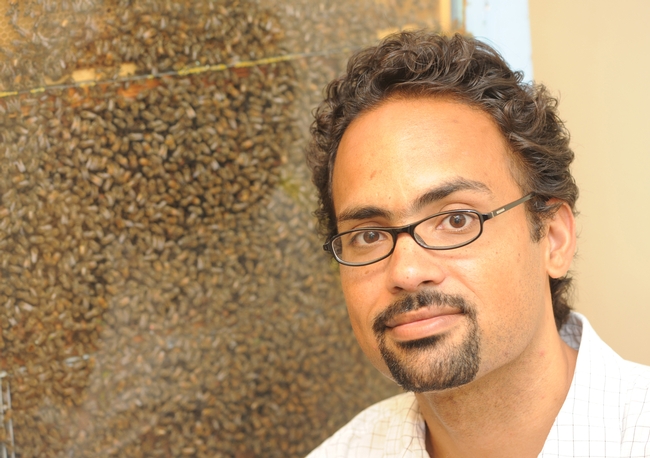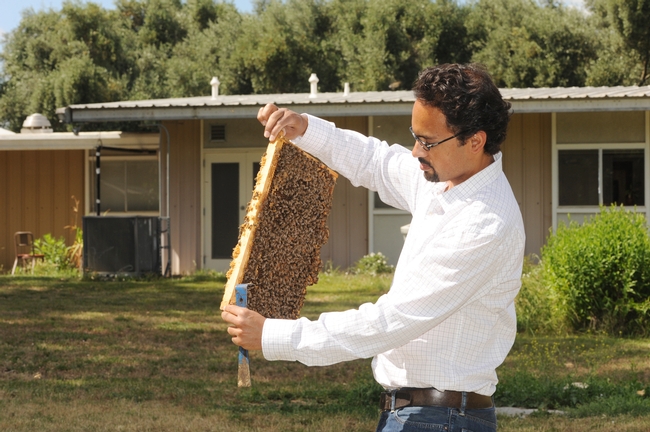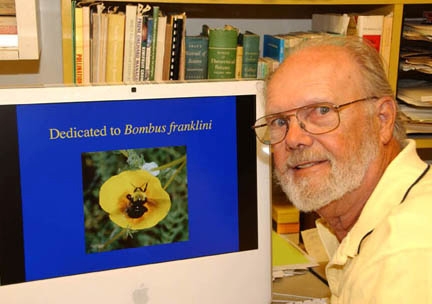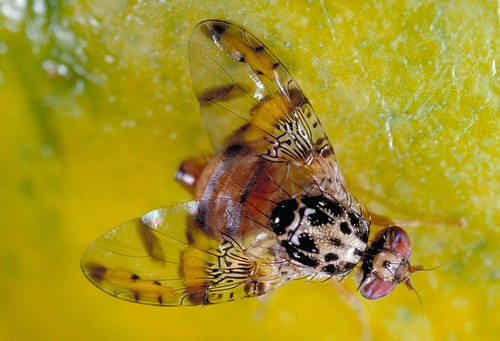
Posts Tagged: James Carey
How Honey Bees Make Collective Decisions
Like to know more about honey bees make collective decisions?Mark your calendar to attend a seminar this week at the University of California, Davis. Brian Johnson, assistant professor at the UC Davis Department of Entomology, will speak on "Organization of Work in the Honey Bee" from 12:10 to 1...

Brian Johnson in front of his bee observation hive. (Photo by Kathy Keatley Garvey)

Brian Johnson checks out a frame at the Harry H. Laidlaw Jr. Honey Bee Research Facility at UC Davis. (Photo by Kathy Keatley Garvey)
The Good, the Bad and the Bugly
"The Good, the Bad, and the Bugly." That's one of the topics at the next meeting of the Northern California Entomology Society, to be held from 9:15 a.m. to 3 p.m., Thursday, May 6 in the Harry H. Laidlaw Jr. Honey Bee Research Facility at UC Davis. It promises to be lively. And bugly. Matter...

Robbin Thorp

The Medfly
Master Gardener criticizes LBAM program
Annie Spiegelman, author of the gardening book "Talking Dirty" and a Master Gardener for UC Cooperative Extension in Marin County, wrote an opinion piece published today in the Huffington Post that mocked CDFA's and USDA's past efforts to eradicate the Light Brown Apple Moth in California.
The author seemed particularly incensed by aerial spraying of pheromones, which was part of the eradication program. In fact, the story was posted with a photo illustration showing a crowded Santa Cruz Boardwalk and beach with a plane releasing a huge white cloud overhead.
In her article, Spiegelman questioned why, during an immense fiscal crisis, $89.5 million was spent to eliminate from the state what she referred to as a "garden variety" and "humdrum" brown moth.
"So I clipped on my Master Gardener trowel-shaped lapel pin and gave the senior entomology faculty at the University of California, Davis, a jingle to see why my tax dollars were being used to stamp out the lackluster 'Light Brown Apple Moth," Spiegelman wrote.
The author noted that UC Davis entomology professors James Carey and Bruce Hammock and UC Davis Cooperative Extension entomology specialist Frank Zalom wrote to Governor Schwarzenegger in 2008 expressing their concern with the planned moth eradication program.
In their letter they said data showing the moth would become more important than other pests already in the state are unconvincing, and there is no scientific evidence that mating disruption is capable of eradicating any insect population.
In a conversation with Spiegelman, Carey reiterated the point that LBAM is not a serious pest."And even if it was a more serious pest, there is zero chance to eradicate it," Carey was quoted in the article. "Eradication is not possible because you're not eradicating an LBAM population but you're trying to eradicate 100,000 LBAM populations. There are millions of pockets of these and each pocket has a separate population."
Zalom told the writer he believes naturally occurring biological control agents will become increasingly important for control of LBAM.
"LBAM will eventually be considered an occasional pest that growers need to be aware of and one, which on occasion will require intervention. It seems to be no greater a threat than a suite of other insect pests that already occur locally," Zalom was quoted.
The Predator and the Prey
If you've ever wondered about the relationship between predator biodiversity and herbivore suppression, that subject is on tap Wednesday, Jan. 27 at UC Davis. The UC Davis Department of Entomology will host associate professor William Snyder (right) of the Department of Entomology, Washington...

James Harwood
Medfly and Moth Wars
James R. Carey is used to dissent. The entomology professor at the University of California, Davis, fervently believes that the Mediterranean fruit fly and light brown apple moth, two exotic and invasive pests, have long been established in California and cannot be eradicated. Trying to eradicate...

James Carey

Light Brown Apple Moth
